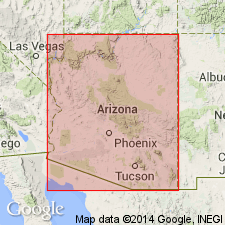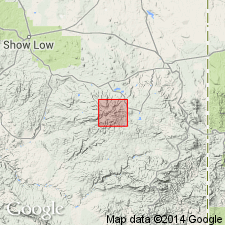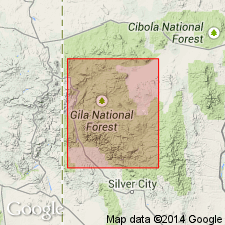
- Usage in publication:
-
- Sheep Crossing Formation
- Modifications:
-
- Named
- Dominant lithology:
-
- Sand
- AAPG geologic province:
-
- Black Mesa basin
Summary:
Pg. 226-229. Sheep Crossing Formation. Mapped over an area of about 10 sq km and is present beyond area currently mapped. Recognized on lower slopes of Mount Baldy and Mount Ord in the White Mountains as patches, commonly near mouths of large valleys. Consists of unstratified, gray-brown gravelly sand with poorly sorted clastic material ranging in size from clay to boulders as large as 6 m in diameter. Boulders include all intermediate and silicic volcanic rock types found on Mount Baldy. Thickness at type section 3.2 m; ranges from 3.2 to 40 m [According to GNU records (USGS DDS-6; Denver GNULEX, Apr. 24, 1989), thickness ranges from less than 1 m to 40 m]. At type, unit overlies an unnamed sedimentary deposit and underlies an olivine basalt that has been dated at 8.9 +/-0.9 m.y. Age is late Miocene.
Type section: railroad cut about 200 m east of Sheep Crossing, in NW/4 SE/4 NW/4 sec. 33, T. 7 N., R. 27 E., southern Apache Co., AZ (Black Mesa basin). Named from locality where AZ Highway 273 crosses West Fork of Little Colorado River, in S/2 NW/4 sec. 33, T. 7 N., R. 27 E., southern Apache Co., east-central AZ.
Source: US geologic names lexicon (USGS Bull. 1520, p. 277); supplemental information from GNU records (USGS DDS-6; Denver GNULEX).

- Usage in publication:
-
- Sheep Crossing Formation
- Modifications:
-
- Revised
- AAPG geologic province:
-
- Black Mesa basin
Summary:
Revised in White Mountains, southern Apache Co, AZ, Black Mesa basin, in that unit is divided into two newly named members: Marshall Butte Member in lower part and Campground Member in upper part. Campground represents deposits originally named Sheep Crossing by Merrill and Pewe (1971). [Though not stated by authors, type section of Campground Member is presumably same as type for Sheep Crossing]. Type section for Marshall Butte is at Marshall Butte approximately 14 mi to southwest of type for Sheep Crossing [and Campground]. [Thus, type for Sheep Crossing now consists of two sections. Rocks now assigned to Marshall Butte were apparently part of unnamed older sediments and volcanics]. Measured section at type for Campground shown to be 304 cm (3.04 m; p. 17) thick and measured section at type for Marshall Butte shown to be about 67 m thick (fig. 13). Thickness of Sheep Crossing [presumably as now revised] ranges from less than 1 to 100 m. Geologic map. Sheep Crossing deposited during time Mount Baldy volcano was active (prior to 8.6 +/-0.4 m.y.) and shortly after it became dormant or extinct and is coeval in part with Mount Baldy Formation (new). Overlies older sediments and volcanics deposited before 12 m.y. ago; underlies basalt dated at 8.9 +/-0.9 m.y. Age is probably middle to late Miocene.
Source: GNU records (USGS DDS-6; Denver GNULEX).

- Usage in publication:
-
- Sheep Crossing Formation
- Modifications:
-
- Geochronologic dating
- AAPG geologic province:
-
- Black Mesa basin
Summary:
Has yielded a date of 9.1 +/-0.9 m.y. (whole rock), [or Miocene], Mount Ord quad, White Mountains, Apache Co, AZ, Black Mesa basin.
Source: GNU records (USGS DDS-6; Denver GNULEX).
For more information, please contact Nancy Stamm, Geologic Names Committee Secretary.
Asterisk (*) indicates published by U.S. Geological Survey authors.
"No current usage" (†) implies that a name has been abandoned or has fallen into disuse. Former usage and, if known, replacement name given in parentheses ( ).
Slash (/) indicates name conflicts with nomenclatural guidelines (CSN, 1933; ACSN, 1961, 1970; NACSN, 1983, 2005, 2021). May be explained within brackets ([ ]).

